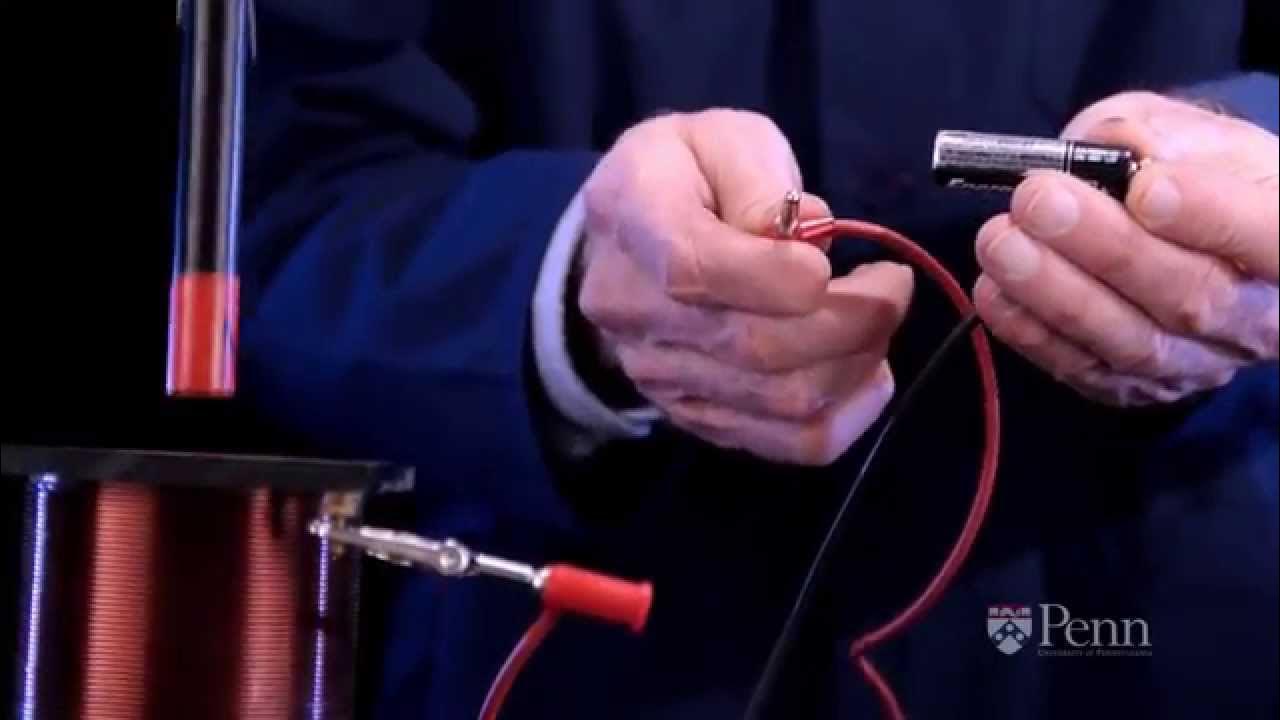Tema 14 - Indução Eletromagnética | Experimento - Lei de Faraday: pêndulo eletromagnético
Summary
TLDRThis video demonstrates an experiment using a suspended magnet (pendulum) and a coil with 4000 turns, along with LED lights. As the magnet oscillates above the coil, it induces an electric current, lighting up the LEDs. The faster the magnet moves, the brighter the LEDs glow, as the magnetic flux changes more intensely. The experiment also shows how short-circuiting the coil increases current flow, dampening the pendulum's motion. Alternatively, when the coil oscillates and the magnet is stationary, the same induction process occurs, emphasizing that only relative motion between them is necessary.
Takeaways
- 🔧 The experiment uses a pendulum attached to a nylon thread, a 4000-turn coil, and LED lights.
- 🎯 The pendulum starts from a certain height, converting potential energy into kinetic energy as it swings.
- 💡 When the magnet (pendulum) passes near the coil, it induces a current, lighting up the LED lamps.
- ⚡ The brightness of the LED lamps depends on the speed of the magnet, which is determined by the height it falls from.
- 📉 As the pendulum loses kinetic energy, less electrical energy is generated, and the LEDs dim.
- 🔄 When the coil's terminals are short-circuited, the pendulum oscillates less because more kinetic energy is converted into electrical energy.
- 🔋 If the coil's terminals are open, no current flows, and the pendulum maintains more of its kinetic energy.
- 🔄 The same effect is observed whether the magnet or the coil is moving, as long as there is relative motion between them.
- 🔍 The experiment demonstrates the relationship between magnetic fields, induced currents, and energy conversion.
- 🔬 Another variation of the experiment is positioning the magnet on a base and letting the coil swing as the pendulum, showing the same principles.
Q & A
What components are used in this experiment?
-The components used in this experiment are a support stand for the pendulum, a magnet attached to a nylon string, a coil with 4000 turns, and LED lights.
What happens when the magnet is released from a certain height?
-When the magnet is released from a certain height, it transforms potential energy into kinetic energy as it swings downwards.
Why do the LED lights turn on as the magnet passes by the coil?
-The LED lights turn on because the magnetic field produced by the moving magnet induces an electric current in the coil, which powers the LEDs.
How does the speed of the magnet affect the brightness of the LED lights?
-The brightness of the LED lights increases with the speed of the magnet because a higher speed causes a greater change in the magnetic flux, producing a stronger electric current.
What happens to the kinetic energy of the pendulum over time?
-Over time, the kinetic energy of the pendulum decreases, which leads to less electrical energy being generated and a reduction in the brightness of the LED lights.
What is the effect of connecting the coil terminals in a short circuit?
-When the coil terminals are connected in a short circuit, the electrical resistance is minimized, allowing maximum current to flow, which significantly reduces the oscillation of the pendulum as more kinetic energy is converted to electrical energy.
What happens if the coil terminals are open instead of connected?
-If the coil terminals are open, there is no flow of electric current, and as a result, the pendulum loses very little kinetic energy and continues to swing for a longer period.
How does the variation in the experiment demonstrate the principles of electromagnetic induction?
-The variation in the experiment shows that electromagnetic induction occurs as long as there is relative motion between the magnet and the coil, regardless of which component is in motion.
What is the main principle demonstrated by this experiment?
-The main principle demonstrated by this experiment is electromagnetic induction, where a changing magnetic field induces an electric current in a conductor.
What factors influence the intensity of the induced current in the coil?
-The intensity of the induced current in the coil depends on the speed of the magnet's movement, the number of turns in the coil, and the strength of the magnet.
Outlines

此内容仅限付费用户访问。 请升级后访问。
立即升级Mindmap

此内容仅限付费用户访问。 请升级后访问。
立即升级Keywords

此内容仅限付费用户访问。 请升级后访问。
立即升级Highlights

此内容仅限付费用户访问。 请升级后访问。
立即升级Transcripts

此内容仅限付费用户访问。 请升级后访问。
立即升级浏览更多相关视频

Faraday's Law - PHET Simulator

Search Coil Experiment (measure magnetic field strength)

Faraday's Law of Induction Demonstration - Penn Physics

#eps4 MEMBONGKAR KEBOHONGAN MAGNET BISA MENGHASILKAN LISTRIK.|| generator free energy

IPA kelas 9 Semester 2 : Kemagnetan (Part 4 : induksi elektromagnet)

Gaya Gerak Listrik Induksi (Hk. Faraday) | Fisika XII
5.0 / 5 (0 votes)
